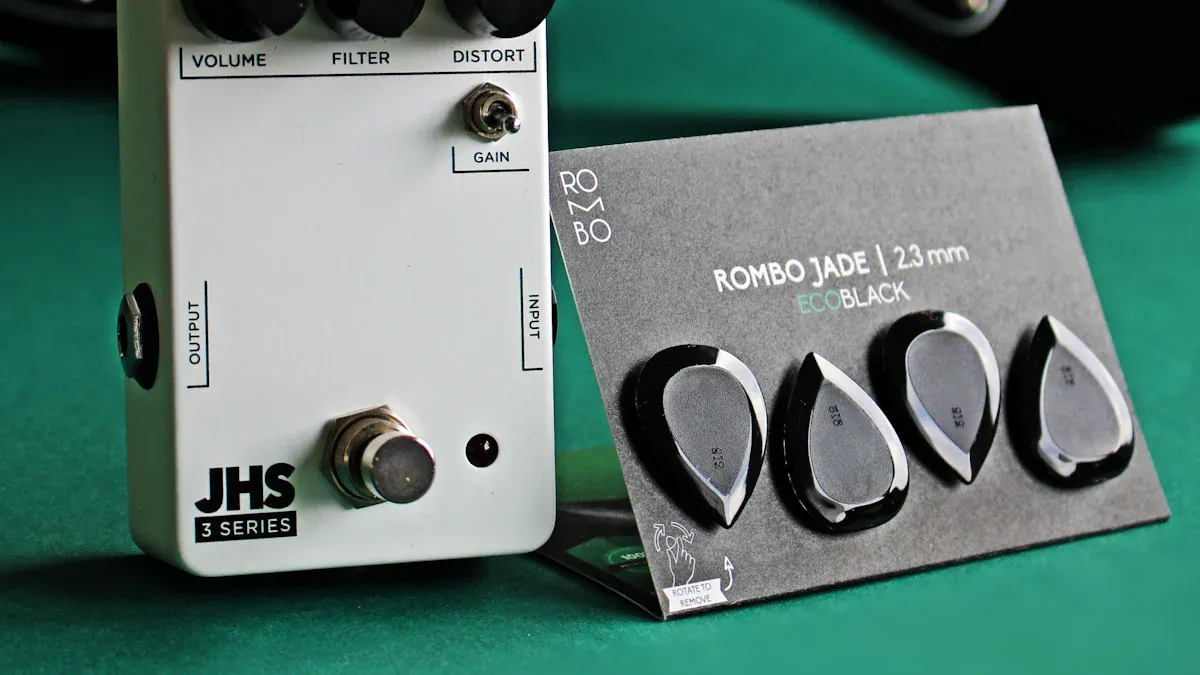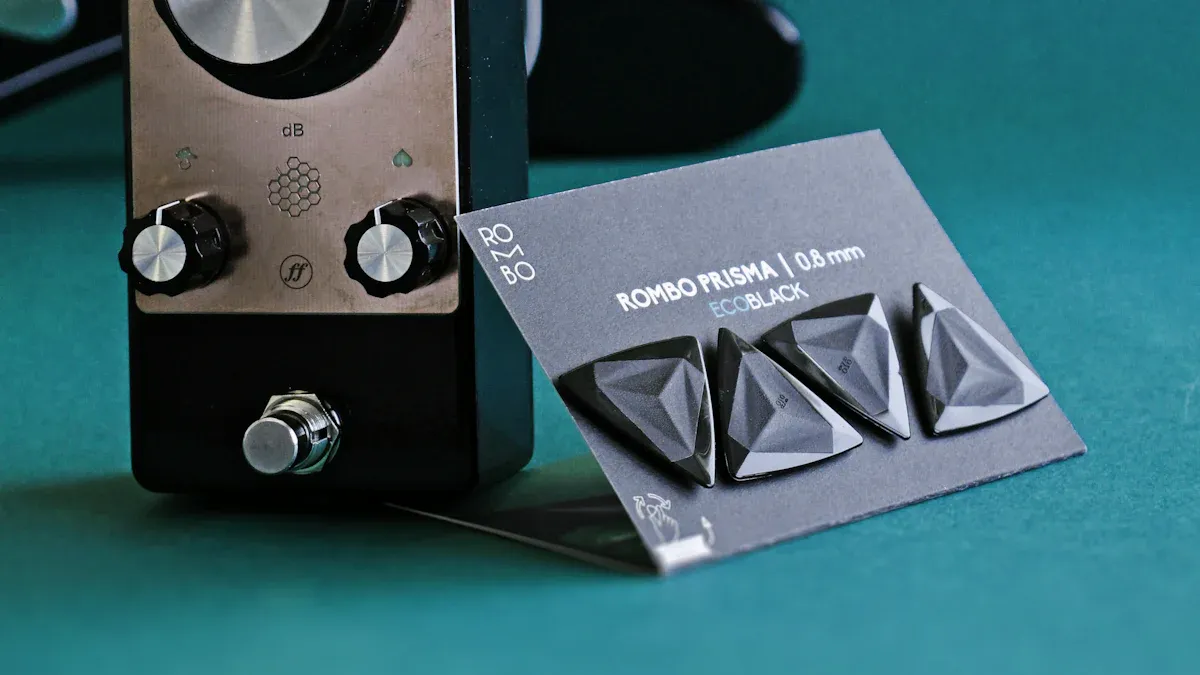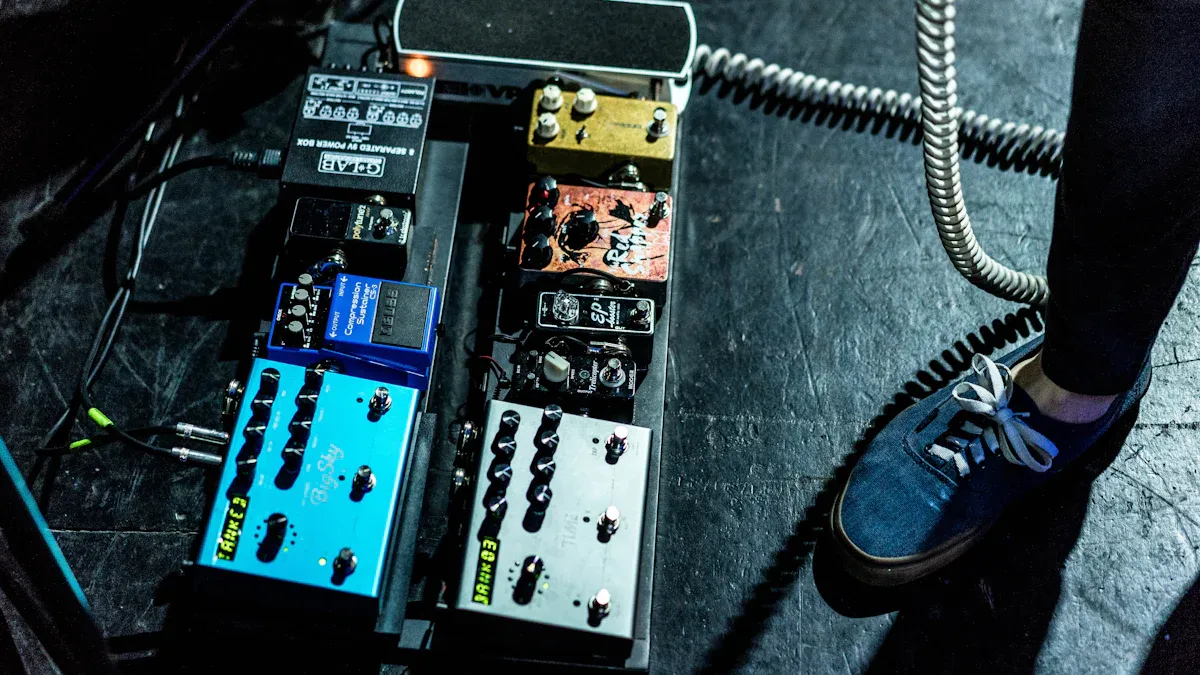
John Mayer uses a compression pedal to shape his guitar sound, favoring models like the Keeley Katana and Strymon OB-1. Compression pedals make the sound thicker, enhance sustain, and keep the volume consistent across every note. Many players find that a compression pedal brings out quiet notes and tames louder ones, resulting in a more balanced performance.
It helps single-coil guitars sound fuller and more powerful.
It delivers a smoother, more even tone.
Fans seeking Mayer’s signature sound can explore pedals such as the Dynamics Super ZlP Factory or the Overdriver Capy Order for similar tonal qualities.
Key Takeaways
John Mayer uses compression pedals like the Keeley Katana and Strymon OB-1. These pedals make his guitar sound thicker and more even.
A dual compressor setup helps Mayer control his guitar’s dynamics better. This gives him more ways to change his sound.
Setting the compressor pedal with a low ratio and slow attack keeps the guitar’s natural feel. It also adds more sustain to the notes.
Where you put the compressor in the signal chain changes the sound. Putting it first shapes the tone. Putting it last mixes the effects together.
Trying different pedals and settings can help players find their own sound. Mayer does this to get his special sound.
Mayer’s Compression Pedal Choices

Keeley Katana and Strymon OB-1
John Mayer picks the Keeley Katana and Strymon OB-1 for his pedalboard. These pedals help him keep his guitar sound strong and clear. The Keeley Katana gives a boost in volume. It does not change how the guitar sounds. Players like it because the controls are easy.
The Strymon OB-1 works as a clean boost and a compression pedal. This pedal helps Mayer play hard songs with clear notes. It makes the sound tight and keeps every note even. Both pedals do not change the sound, which helps Mayer get a thick and warm tone.
Tip: Many guitarists want pedals that keep their sound the same. Clean boosts and compression pedals like these help players sound professional.
Comparison Table: Keeley Katana vs. Strymon OB-1
Pedal Name | Main Function | Качество звука | Extra Features |
|---|---|---|---|
Keeley Katana | Clean Boost | Transparent | Simple Operation |
Strymon OB-1 | Boost + Compression | Tight, Clear Notes | Dual Functionality |
Dual Compressor Setup
John Mayer uses two compressor pedals to shape his sound. He often picks the Analog Man Mini Bi-Comp, which has two classic compression circuits. This setup lets him control his guitar’s dynamics better.
Mayer puts the compressor first in his signal chain. This spot affects all the pedals after it. The result is a smooth and even sound. Using two compressors helps Mayer change his tone for different songs and styles.
The dual compressor setup gives Mayer more ways to shape his sound.
It makes the natural dynamics of his guitar better.
Putting the compressor first helps the whole pedalboard sound balanced.
Note: Using two compression pedals can help players find new sounds and control their dynamics better.
Compression Pedal in Mayer’s Tone
Sound Shaping: Tailoring the Compression for Tone and Feel
John Mayer uses a compression pedal to shape his guitar sound. He adjusts the settings to match the feel of each song. The pedal helps him control the volume of every note. It makes quiet notes louder and loud notes softer. This creates a smooth and even sound. Mayer likes to keep the natural dynamics of his playing. He sets the pedal to add sustain without losing the touch and feel of his guitar.
Compression adds sustain without killing dynamics – a Mayer must-have.
Many guitarists notice that Mayer’s tone feels alive and expressive. The compression pedal gives his solos extra sustain. It also helps chords ring out clearly. Players who want a similar sound should experiment with different settings. They can change the attack and release to find the right balance. Mayer’s approach shows that careful use of compression can improve both tone and feel.
Signal Chain Placement: Positioning the Compressor in the Pedalboard
Mayer places his compressor pedal in different spots on his pedalboard. Sometimes he puts it first to shape the sound before other effects. This placement controls the dynamics early in the signal chain. Other times, he uses the LA Studio Comp at the end of the chain. This boosts his solos and glues the sound together.
The compressor is set at a ratio of 2:1 with a slower attack to catch peaks while preserving pick attacks.
John Mayer places his LA Studio Comp at the end of his signal chain, which enhances the overall sound and serves as a solo boost.
The compressor is used to glue the sound together while allowing the dynamics of playing to remain intact.
Players can learn from Mayer’s setup. Placing the compression pedal first gives control over the whole signal. Putting it last helps blend all effects and boost solos. Each position offers a different result. Experimenting with placement helps players find their own sound.
Settings and Common Mistakes
Recommended Settings
Many guitarists want to match John Mayer’s sound. They often look for the right settings on their compression pedal. Mayer usually sets his compressor with a low ratio, such as 2:1. This setting keeps the sound natural and smooth. He also uses a slower attack. This lets the first part of each note come through. The release time stays short, so the compressor stops working quickly after each note. These settings help Mayer keep his playing expressive.
A good starting point for most players includes:
Ratio: 2:1 or lower
Attack: Slow
Release: Fast
Output Level: Adjust to match the bypassed signal
Players should listen to their own sound and adjust these settings. Every guitar and amp can react differently. Mayer’s settings work well for clean tones and solos. Players can experiment to find what fits their style best.
Tip: Small changes in attack and release can make a big difference in feel and response.
Pitfalls to Avoid
Many guitarists make mistakes when trying to copy Mayer’s tone. Some misunderstand the role of compression in shaping sound. Others use settings that do not fit their playing style. Many forget to think about the whole sound when adding a compression pedal.
Common mistakes include:
Ignoring the context of the full band mix
Setting the compressor too strong, which can kill dynamics
Believing Mayer always uses a compressor for his clean sound
Some fans think Mayer’s clean tone comes only from a compressor pedal. In reality, his amplifiers and playing style play a big part. Mayer also avoids using compression on his acoustic guitar. He likes to control volume with his hands. In live or studio mixes, engineers may add compression to help the guitar fit with other instruments.
Note: Mayer’s signature sound comes from many factors, not just the pedal settings.
Alternative Compression Pedals
Musontek Dynamics – Super ZlP Factory
Many guitarists want a good compression pedal that is not expensive. The Musontek Dynamics – Super ZlP Factory is a great pick for those who like Mayer’s sound. This pedal helps control how loud or soft the guitar is. It makes quiet notes louder and loud notes softer. This gives a smooth and even sound.
Musontek made the Dynamics – Super ZlP Factory for all skill levels. The pedal has easy controls for threshold, ratio, attack, release, and output level. Players can change these settings to fit their own style. The pedal works for both light and strong compression. It is built tough, so it works well on stage or in the studio.
The Dynamics – Super ZlP Factory keeps the sound clear and natural. It uses special parts to cut down on noise. Players notice their tone stays real and full of feeling. The pedal also helps notes last longer and makes chords and solos stand out.
Tip: Musontek’s Dynamics – Super ZlP Factory gives pro-level compression for less money.
Comparison Table: Musontek Dynamics – Super ZlP Factory Features
Характеристика | Описание |
|---|---|
Professional-grade compression | Ensures high-quality sound and performance suitable for professional use. |
Musical transparency | Maintains the integrity of the original sound while applying compression. |
Intuitive controls | User-friendly interface for easy adjustments and settings. |
Versatile dynamic control | Capable of both subtle and pronounced compression effects. |
Minimal noise | Superior circuitry designed to reduce unwanted noise during operation. |
Maximum musical enhancement | Enhances the overall musical quality of the sound produced. |
Other Options
Players who want more choices can look at other pedals. The Keeley Compressor Plus gives a smooth and clear sound. The Xotic SP Compressor is small and easy to use. The Boss CP-1X uses new tech for better control. Each pedal has special features to help shape the sound.
Some pedals keep the sound clear. Others change the sound a bit. Players should try different pedals to see what they like best. Testing pedals in person helps players hear the difference. Many stores let you try pedals before you buy.
Note: Picking the right compression pedal depends on what the player wants and their music style.
Live vs. Studio Use

Setup Differences: Understanding the Impact of Different Configurations and Environments
John Mayer changes his pedal setup for each place he plays. At live shows, he wants his sound to be strong and clear. He puts his compressor pedal near the start of his signal chain. This helps control how loud or soft his notes are before other effects change the sound. The pedal makes his playing smooth and helps every note be heard on stage.
In the studio, Mayer does things differently. He sometimes puts the compressor later in the chain or uses special studio rack compressors. Studio setups let him control the sound more exactly. Engineers use advanced gear to adjust compression. Mayer can try different settings to match the mood of each song.
Table: Live vs. Studio Compression Setup
Environment | Compressor Placement | Goal | Tools Used |
|---|---|---|---|
Live | Начало цепочки | Consistent dynamics | Pedalboard compressor |
Studio | End of chain/rack | Detailed control | Rack/studio compressor |
Tip: Players should test where they put their pedals at home before playing live or recording.
Adapting Compression: Tailoring Compression Techniques for Different Needs and Environments
Guitarists need to change compression settings for each place they play. On stage, Mayer uses simple controls. He sets a low ratio and slow attack to keep his sound real. Fast release times help notes last longer. These settings work well with loud amps and busy mixes.
In the studio, Mayer and engineers make more careful changes. They adjust threshold and ratio for each song. Studio compression can be light or strong, depending on what the song needs. Mayer sometimes uses more than one compressor for extra control.
Live settings help the guitar sound clear and steady.
Studio settings let Mayer shape his sound in creative ways.
Players should listen closely and change compression for each place they play. They can start with Mayer’s settings and change them to fit their own style. Trying different pedals, like the Musontek Dynamics – Super ZlP Factory, helps players get the best sound anywhere.
Note: Good compression helps guitar sound great both live and in the studio.
John Mayer uses compression pedals to make his guitar sound smooth and expressive. Players can get a similar sound if they pick the right pedal and set it up carefully. Musontek’s Dynamics – Super ZlP Factory has pro features but does not cost a lot. Many experts also suggest these cheaper pedals:
Strymon Compadre – Studio-level compression
Mooer Yellow Comp – Easy to use and affordable
Source Audio Atlas – Advanced studio-level compression
Trying different pedals and settings helps players find their own special sound.
FAQ
What does a compressor pedal do for guitarists?
A compressor pedal helps control how loud each note is. It makes soft notes louder and loud notes softer. This gives guitarists a smooth and even sound.
Does John Mayer always use a compressor pedal?
John Mayer uses a compressor pedal with his electric guitar. He does not use one for his acoustic guitar. His sound also comes from how he plays, his amps, and his pedals.
Can beginners use the Musontek Dynamics – Super ZlP Factory?
Yes, beginners can use the Musontek Dynamics – Super ZlP Factory. The pedal has easy controls. Players can change the settings and learn how compression works.
Where should a compressor pedal go in the signal chain?
Most guitarists put the compressor pedal first in the signal chain. This spot shapes the sound before other effects. Some players put it last to mix all the effects together.